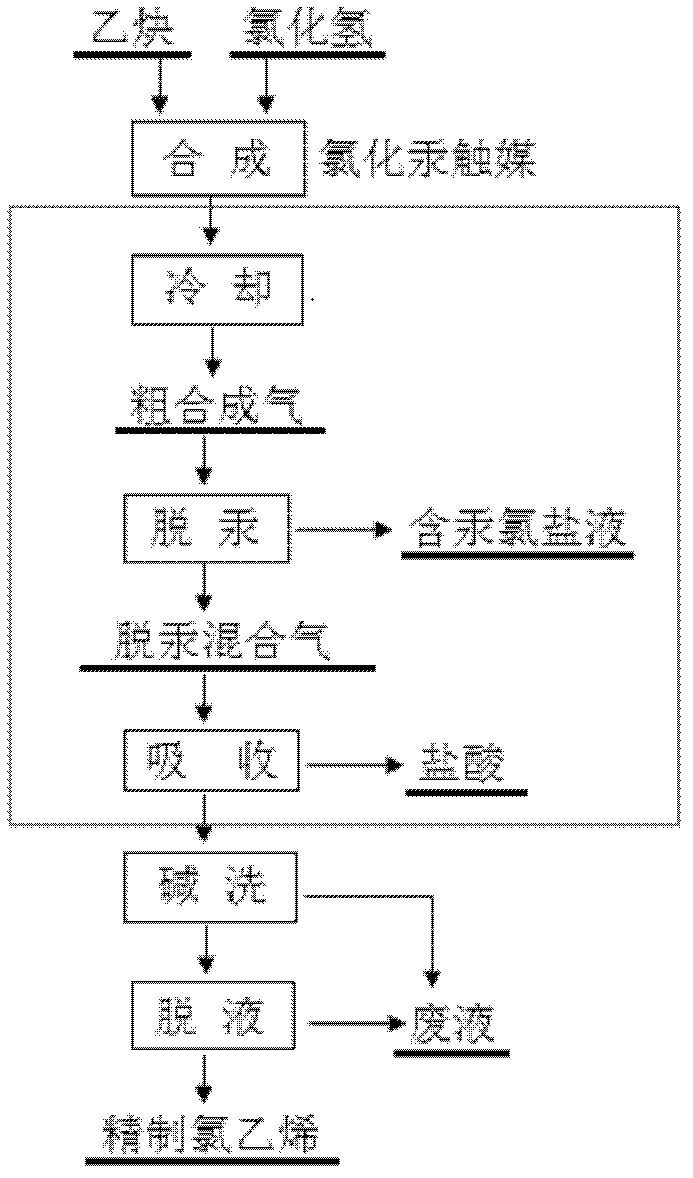Comprehensive processing method of vinyl chloride synthetic gas
A comprehensive treatment of vinyl chloride technology, applied in the direction of chlorine/hydrogen chloride, hydrogen halide addition preparation, mercury halide, etc., can solve the problems of high cost and complicated treatment process, achieve short treatment process, convenient process operation, and good for health The effect of development
- Summary
- Abstract
- Description
- Claims
- Application Information
AI Technical Summary
Problems solved by technology
Method used
Image
Examples
Embodiment 1
[0040] Mercury removal solution is 3.5mol / L MgCl 2 , 1.5mol / L HCl aqueous solution. A combination of 3-stage towers is used for mercury removal, and the synthesis gas enters from the 1st stage and is discharged after passing through the 2nd and 3rd stages in turn; the operating parameters of the three-stage towers are the same.
[0041] Cool the crude vinyl chloride synthesis gas coming out of the tower to 75-78°C; introduce it into a 3-stage tower combination for mercury removal; and then introduce the mercury-removed mixed gas into a 2-stage combination to absorb hydrogen chloride. When the mercuric chloride content in the first-stage mercury removal liquid reaches 40g / L, it is discharged, and the liquid after mercury removal in the second-stage tower is transferred to the first-stage tower, and the liquid after mercury removal in the third-stage tower is transferred to the second stage tower, and the third-stage tower is replaced with a new mercury removal solution.
[00...
Embodiment 2
[0046] Mercury removal solution is 4.2mol / L CaCl 2 , 0.1mol / L HCl aqueous solution. The combination of two-stage towers is used for mercury removal, and the synthesis gas enters from the first stage and is discharged after passing through the second stage; the operating parameters of the two towers are the same.
[0047] Cool the crude vinyl chloride synthesis gas out of the tower to 45-50°C; introduce it into a 2-stage tower combination for mercury removal; and then introduce the mercury-removed mixed gas into a 2-stage combination to absorb hydrogen chloride. When the mercury chloride content in the mercury removal liquid of the first stage of mercury removal reaches 30g / L, it is discharged, and the liquid after mercury removal in the second stage tower is transferred to the first stage tower, and the second stage tower is replaced with a new mercury removal liquid.
[0048] After removing hydrogen chloride, the mixed gas is removed by cyclone to remove acid mist, alkali wa...
Embodiment 3
[0052] Mercury removal solution is 4.0mol / L CaCl 2 , 0.5mol / L HCl aqueous solution. Two-stage combined towers are used for mercury removal, and the synthesis gas enters from the first stage and is discharged after passing through the second stage; the operating parameters of the two-stage towers are the same.
[0053] Cool the crude synthesis gas out of the tower to 60-65°C; introduce it into a 2-stage combined tower for mercury removal; When the mercury chloride content in the first-stage mercury removal liquid reaches 30g / L, it is discharged, and the second-stage mercury removal liquid is transferred to the first-stage tower, and the second-stage mercury removal liquid is replaced with a new one.
[0054] After removing hydrogen chloride, the mixed gas is removed by cyclone to remove acid mist, alkali washing and neutralization, and cyclone to remove water mist to obtain refined vinyl chloride.
[0055] The composition of the discharged mercury removal liquid is: HgCl 2 ...
PUM
 Login to View More
Login to View More Abstract
Description
Claims
Application Information
 Login to View More
Login to View More - R&D
- Intellectual Property
- Life Sciences
- Materials
- Tech Scout
- Unparalleled Data Quality
- Higher Quality Content
- 60% Fewer Hallucinations
Browse by: Latest US Patents, China's latest patents, Technical Efficacy Thesaurus, Application Domain, Technology Topic, Popular Technical Reports.
© 2025 PatSnap. All rights reserved.Legal|Privacy policy|Modern Slavery Act Transparency Statement|Sitemap|About US| Contact US: help@patsnap.com

